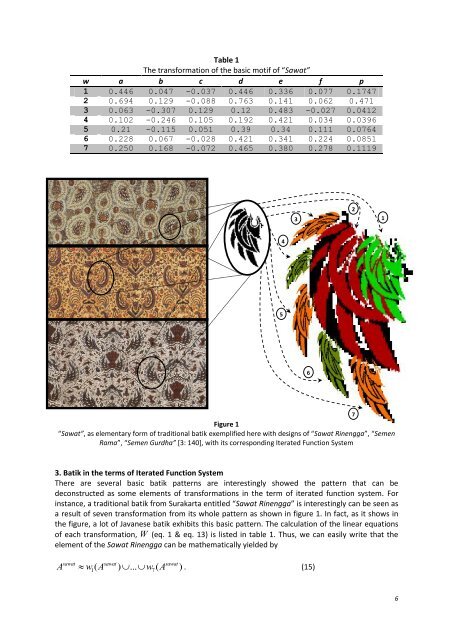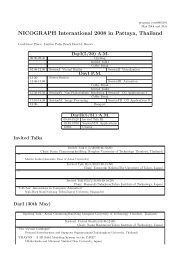Deconstructing Javanese Batik Motif
Deconstructing Javanese Batik Motif
Deconstructing Javanese Batik Motif
You also want an ePaper? Increase the reach of your titles
YUMPU automatically turns print PDFs into web optimized ePapers that Google loves.
Table 1The transformation of the basic motif of “Sawat”w a b c d e f p1 0.446 0.047 -0.037 0.446 0.336 0.077 0.17472 0.694 0.129 -0.088 0.763 0.141 0.062 0.4713 0.063 -0.307 0.129 0.12 0.483 -0.027 0.04124 0.102 -0.246 0.105 0.192 0.421 0.034 0.03965 0.21 -0.115 0.051 0.39 0.34 0.111 0.07646 0.228 0.067 -0.028 0.421 0.341 0.224 0.08517 0.250 0.168 -0.072 0.465 0.380 0.278 0.11193214567Figure 1“Sawat”, as elementary form of traditional batik exemplified here with designs of “Sawat Rinengga”, “SemenRama”, “Semen Gurdha” [3: 140], with its corresponding Iterated Function System3. <strong>Batik</strong> in the terms of Iterated Function SystemThere are several basic batik patterns are interestingly showed the pattern that can bedeconstructed as some elements of transformations in the term of iterated function system. Forinstance, a traditional batik from Surakarta entitled “Sawat Rinengga” is interestingly can be seen asa result of seven transformation from its whole pattern as shown in figure 1. In fact, as it shows inthe figure, a lot of <strong>Javanese</strong> batik exhibits this basic pattern. The calculation of the linear equationsof each transformation, W (eq. 1 & eq. 13) is listed in table 1. Thus, we can easily write that theelement of the Sawat Rinengga can be mathematically yielded byA w ( A ) ... w ( A ) . (15)sawat sawat sawat1 76



